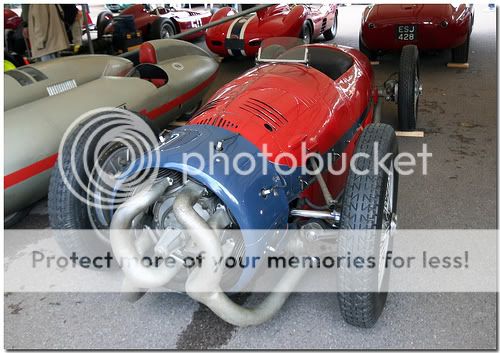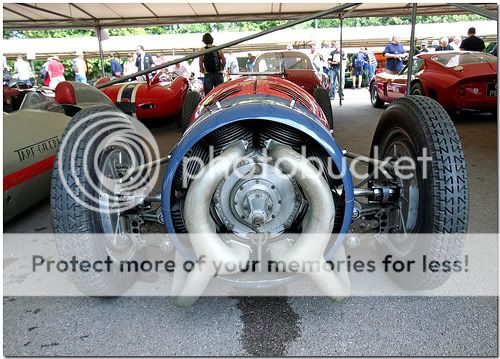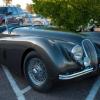1935 Trossi-Monaco 16 cylinder (merged)
#1

Posted 19 February 2002 - 19:45
Count Trossi...built a aero engined 16 cylinder (front mounted aka. Morgan 3 wheeler air cooled) Grand Prix racer..any photo's or information out there...
Peter
www.autodromo.biz
Advertisement
#2

Posted 19 February 2002 - 21:09
Chez Leif´s site
I´ll scan some pics and post them later (tonight?)
Un abrazo
Felix
#3

Posted 19 February 2002 - 21:42
Rumor has it ; The Trossi-Monaco tested at the Autodromo...true? ... what a Beast!
Peter
www.autodromo.biz
#4

Posted 19 February 2002 - 21:55
There is a description of the Trossi Monaco in Doug's "Motor Racing Mavericks" - the car did indeed run at Monza, achieving 155mph on one occasion, but it never raced. It's radial engine apparently had a voracious appetite for plugs and was also prone to overheating. I provided Leif with some of the detail on his site, with Doug's text as the main source.
At the time of publication (1974), the car was in the Biscaretti Museum - presumably they still have it?
#5

Posted 19 February 2002 - 22:42

What´s the source for that drawing, Peter?
I have a couple of pictures from Alberto Mallo´s "Los monstruos sagrados de la competición", the majority of which were taken at the Biscaretti Museum plus one or two from the Monza test...
Back in a while ;)
Felix
#6

Posted 19 February 2002 - 23:26




Whilst these two are contemporary pictures. This one is supposed to be the Monza tests

and this one too, although the only thing for sure is the identity of the driver...

Finally, there is also that well known picture showing Giulio Aymini at the wheel of the car at Monza (a small version can be found in Jenks´"The Batsford Guide to Racing Cars", p.187) but unfortunately I cannot remember where it is! Any takers?
Felix
#7

Posted 20 February 2002 - 10:16
As far as I recall (I've been there working in the archive
BTW, the museum has an URL:
http://www.museoauto.org/
but Trossi's car is not illustrated.
Best regards to all
#8

Posted 20 February 2002 - 14:19
The quote below the photo...goes like this:
Count Carlo Felice Trossi, known to his friends as "Didi" was an Anglophile Itialian aristocrat whose hobbies included speedboats, aircraft and cars. He was President of the Scuderia Ferrari in 1932 and was described by Ferrari as a great racing driver. In his very first race, the Mille Miglia-he came second in the 8C 2300 Alfa Romeo he shared with his friend the Marquis "Tonino" Brivio. He competed at Gaisberg, Alessandria (second to Nuvolari), Florence, and set a new lap record at Monaco in 1934 in his P3 Alfa Romeo monoposto racer.
He enjoyed many other successes. He died of cancer in Milan in 1949 a year after coming second to Wimille in the Monza GP.
_______________________________________________________________________________
Note: I wonder if the racer handled so badly, was because the huge tyres & wheels on the front not matching the rears..
from Lief Kolumbus site:
front tyres...5.25 x 31"
rear tyres... 4.40 x 27"
Weight distribution of 75%F 25% R
perhaps need a heavier driver?
Any comments on that issue...?
And, why would the museum paint the car "Silver" ?
The Orange & Blue looks great and different...non RED car from Italy...(nice)
Peter
www.autodromo.biz
#9

Posted 20 February 2002 - 21:13
One of numerous nice surprises there, including some amazing old GP engines arranged on benches.
#10

Posted 20 February 2002 - 22:44
One of six 10 cylinder engines was an engine called the French Anzini. Which, the less said about it the better for everyone! It was I guess a Rotary Radial. It certainly was not the engine that the German had in the Siemens-Halske, which was good for the Allies!
Yours M.L. Anderson
#11

Posted 20 February 2002 - 22:57
The radially-disposed engine was mounted in the extreme nose, with its eight finned blocks positioned around a central crankcase. Each block carried twinned cylinders and pistons with common conjoining combustion chambers as used by Z and Zoller.

#12

Posted 20 February 2002 - 23:14
Originally posted by marion5drsn
O.K. O.K. who is trying to pull our collective leg. To the best of my knowledge there was never a 16-cylinder radial engine. Firstly radial engines almost have to be built in rows of odd numbers of cylinders usually 3, 5,7 or 9! If there is more than a single row then the number is a 14 or 18 cylinder. Radials have been built in even numbers but designers found out very quickly that it was, for reasons of simplicity easier to build them in odd numbers. This one looks to be seven cylinders.
One of six 10 cylinder engines was an engine called the French Anzini. Which, the less said about it the better for everyone! It was I guess a Rotary Radial. It certainly was not the engine that the German had in the Siemens-Halske, which was good for the Allies!
Yours M.L. Anderson
The Racing Car by Clutton, Posthumus and Jenkinson says that it was a two-stroke. Would that make a difference?
#13

Posted 20 February 2002 - 23:26
There were two master connecting-rods attached to the crank pins, each one carrying seven other articulated rods in normal two-stroke duplex-cum-aero engine manner. Bore and stroke dimensions were 65mm X 75mm and the engine's capacity was 3982cc, making it the biggest European two-stroke thus far in racing.
(1 + 7) X 2 = 16 ...
#14

Posted 21 February 2002 - 07:22
The thing had terminal understeeer. If there was a problem with front tyres, it was that they were too small !!!
That weight distribution is the worse I' ve ever seen; of course it comes from the peculiar engine placing. As a rule of thumb, the more forward biased is your weight distribution, the more understeer you have...
About the even cylinders' number : it was a two stroke, and what Marion correctly said about radial engines applies only to 4 strokes.
#15

Posted 21 February 2002 - 08:48
#16

Posted 21 February 2002 - 10:45
For the record it was a 16 cyl. 2 stroke (3982cc) Each of the 8 "blocks" had 2 cylinders with common combustion chambers...intake at the rear with 2 Zoller Superchargers, and the exhaust to the front with a 4 pipe collector leading to each side of the car.
I guess the problem with "eating" spark plugs was this system of 2 cylinders in each chamber,and being 2 stroke, or because of the overheating of the engine, might also have caused it. Maybe they needed to place a small prop. on the engine for cooling...thus adding forward motion... I would like to see the competitors when this beast with prop coming after you from behind.....LOOK OUT! ha.
Peter
www.autodromo.biz
#17

Posted 21 February 2002 - 10:56
Originally posted by MOTORSPORT RESORT
....Each of the 8 "blocks" had 2 cylinders with common combustion chambers...intake at the rear with 2 Zoller Superchargers, and the exhaust to the front with a 4 pipe collector leading to each side of the car....
This is some whacko engine, if you don't mind me adding to the discussioin... Were the cylinders acting together, or was one pumping into the other, further compressing the mixture?
I guess the problem with "eating" spark plugs was this system of 2 cylinders in each chamber,and being 2 stroke, or because of the overheating of the engine.....
The experience of the Chamberlain 8 in Australia through this period shows up the frailties of spark plugs in this era. Someone carried a nice article on this car in their own magazine back in the seventies, and among the details of its arrival at a useful performance level was the development of decent plugs during WW2.
No real conclusions can be drawn other than that maybe the engine was before its time...
#18

Posted 21 February 2002 - 11:39
My understanding is that it had 2 cylinders and pistons with common conjoining combustion chambers.. Three piece crank shaft located in a duralumin crank case. Th rods were of radial engile type, with one master rod connecting to the seven other rods for each row.
2 Zoller Superchargers with pressure of 0.68 atm. fed through a Xenth carb.
note: this from...www.kolumbus.f1/lief.snellman/c8b.htm (MONACO TROSI)
I want to try it on the Autodromo..
Peter
www.autodromo.biz
#19

Posted 21 February 2002 - 12:10
Bet this lot made a racket out those exhausts... need someone to polish the hubcaps when you take that drive?
#21

Posted 21 February 2002 - 20:23
Originally posted by Felix Muelas
Finally, there is also that well known picture showing Giulio Aymini at the wheel of the car at Monza (a small version can be found in Jenks´"The Batsford Guide to Racing Cars", p.187) but unfortunately I cannot remember where it is! Any takers?
I guess there´s something wrong when one start quoting himself and answering his own questions
MotorSport, October 1998, page 43. Illustrates a (beautifully named) article by Gordon Cruickshank "Mad, bad and dangerous to know" and... it´s a Ludvigsen Library pic (so I will not scan it)
Felix
#22

Posted 21 February 2002 - 21:17
Bobbo
#23

Posted 22 February 2002 - 18:11
It’s a two stroke and yes it does make a difference in that it does not have a series of cam plates for the valves. Also the two superchargers provide the necessary substitute crankcase pressurization for a two stroke. I think G.M. did this several years previous in Diesel two-strokes. To do this at that period would require a positive displacement supercharger. The Zoller doesn’t look like Roots-Connersville, just what type of supercharger were they?
After a little more consideration I just can’t figure why he used two pistons in adjacent chambers. The cooling of the two cylinders would seem to be very shaky. One only has to read about the Curtiss-Wright R-3350 and their problems with cooling in the B-29 to see the troubles. We won’t get into the Pratt & Whitney and their R-4300. The problem of cooling twin/triple row air-cooled radials is an art unto itself.
The one area where I read about the rows being behind one another is also a shaky design as all other twin row radials the rear cylinders are staggered in-between the front row and a lot of sheet metal deflectors to guide the air to the spark plug and the exhaust valve areas. I wish they had some pictures that would have shown the top of the cylinder head to give us some idea of the air passages.
I doubt that the spark plugs were the problem but the cooling of the plugs was very likely a part of the problem. Just sticking out into the air isn’t enough, one has to make sure the air is flowing around the plug and the seat of the plug is cooling the base of the plug. The idea of putting a fan in front of the engine to make sure of proper cooling of the total engine was used on the F-W 190A when they had cooling problems. However this was 5 years after this car. Yours M.L. Anderson
#24

Posted 22 February 2002 - 18:52
Maybe some sort of exhaust covering, would keep it cool...and todays Spark Plugs, for sure are much more advanced...who knows?...What fuel did it run in those days? was there a "spec" fuel used for this type of GP racer in 1935?... (thats a good thread subject)...with some slight modifications the car might work...
What about the handling? ...Any ideas
This is 2002 we must know the answers...¿¿??
Peter
www.autodromo.biz
#25

Posted 23 February 2002 - 20:12
"Our Trossi-Monaco 16cyl."
.....It's a wonderfull car displayed in our Sport Section....
Peter
www.autodromo.biz
#26

Posted 07 March 2007 - 22:53
Why did they use two cylinders in a pairing instead of one big one? - probably due to the mass of the pistons that have to be stopped and reversed twice with each turn of the crank. Two smaller cylinders would have reduced the piston mass and thus the loads on the rods and rod bolts and this permits higher rpm. Higher rpm = more horsepower. Same reason why Ferrari's are typically twelve cylinders when you could get the same displacement with 8 cylinders (or even one!) for less expense and complexity.
For the person who asked why Trossi didn't stagger the rear cylinders in between the fronts, ducting air should have had the same effect, while staggering the cylinders would have made the common combustion chambers larger but this likely would have reduced the compression ratio.
Everything in engine design is a compromise. Designing internal combustion engines is not unlike breeding dogs. All dogs evolved from wolves and still carry all the genes needed to breed them back into wolves. When the first wolves were intentionally bred by humans, they were probably just favoring the traits of friendliness to humans, but over many years, different traits were favored, (but always at the expense of some other trait). Thus Dachshunds were bred for chasing small animals into their tunnels, but didn't do as well in deep snow as St. Bernard's, etc, etc.
The same basic priciples apply to engine design - The common denominator is that you want to ignite a compressed fuel/air mixture and convert it into work - whether it's a torquey Diesel farm tractor, a sporty, high-revving Wankel rotary, a cheap & lightweight two-stroke chainsaw, a Chevy Big-Block Can-Am motor, or an expensive but lightweight & compact-for-its-high-horsepower aircraft turbine that has very high exhaust thrust.
Whatever factors you want to enhance determine which compromises you make. For light weight chainsaws, two-strokes work great, but for emissions control and fuel economy, four strokes are better. For high-horsepower-to-weight four-strokes, high rpm is better, but this means multiple smaller pistons to reduce their reciprocating mass, but this compromises expense, engine size & complexity (i.e. BRM's long V-16's, followed by the H-16's clever packaging layout) In recent years, F1 engine designers have favored V-10's as a good packaging compromise over previously favored 8 & 12 cylinder engines. An 8,000 horsepower funny-car drag racing motor that has to be rebuilt after every 3-second quarter-mile run is an extreme example of compromising everything to favor one type of objective - getting away from a stoplight faster than the next guy...
The Trossi-Monaco was a clever attempt to explore the possible advantages of a two-stroke, supercharged aircooled radial layout over the conventional designs of it's day. It didn't work out, but had he succeeded better, we might all be driving two-stroke, air-cooled radials, while laughing about the olden days when silly engineers used to put I-4 and V-8 engines in cars (What a simplistic idea - What were they thinking? LOL).
#27

Posted 08 March 2007 - 09:26
Originally posted by Motorace
I remember researching this car some years ago, and reading that the overheating problem was all in the rear cylinders in each pairing - they just could not get enough cooling air to them no matter how they ducted it. (I think I remember seeing some pictures with a cowling and others without).
Why did they use two cylinders in a pairing instead of one big one? - probably due to the mass of the pistons that have to be stopped and reversed twice with each turn of the crank. Two smaller cylinders would have reduced the piston mass and thus the loads on the rods and rod bolts and this permits higher rpm. Higher rpm = more horsepower. Same reason why Ferrari's are typically twelve cylinders when you could get the same displacement with 8 cylinders (or even one!) for less expense and complexity.
For the person who asked why Trossi didn't stagger the rear cylinders in between the fronts, ducting air should have had the same effect, while staggering the cylinders would have made the common combustion chambers larger but this likely would have reduced the compression ratio.
There seems to be a bit of misunderstanding of the twin-piston two-stroke here (why two pistons, not one big one?).
You have two pistons, either in parallel cylinders linked by the combustion chamber (e.g. Trossi-Monaco, Trojan) or in opposite ends of the same cylinder with a combustion chamber between (e.g. Junkers Jumo, Napier Deltic, Commer TS3/4) so that one piston controls the inlet ports and the other the exhaust.
No only does that give unidirectional flow of the gases (unlike the Day-cycle (lawnmower) engine) but it allows the exhaust to be timed to open ahead of the inlet.
Edited to add: I like the photo of the T-M you've posted in another place.
#28

Posted 14 March 2007 - 09:06
Originally posted by Allan Lupton
There seems to be a bit of misunderstanding of the twin-piston two-stroke here (why two pistons, not one big one?).
You have two pistons, either in parallel cylinders linked by the combustion chamber (e.g. Trossi-Monaco, Trojan) or in opposite ends of the same cylinder with a combustion chamber between (e.g. Junkers Jumo, Napier Deltic, Commer TS3/4) so that one piston controls the inlet ports and the other the exhaust.
No only does that give unidirectional flow of the gases (unlike the Day-cycle (lawnmower) engine) but it allows the exhaust to be timed to open ahead of the inlet.
Edited to add: I like the photo of the T-M you've posted in another place.
Thank you very kindly for your explanation of the reasons for using two cylinders per combustion chamber in the Trossi-Monaco. I'm curious to know how efficiently the forward cylinder could fill given that the charge had to pass from the rear cylinder and through the restriction of the combustion chamber to fill the forward cylinder...
http://www.auto-mobi...saperi/f116.jpg
#29

Posted 14 March 2007 - 13:22
The opposed piston layout (Junkers Jumo/Napier Deltic/Commer TS) would be better: many were diesel so a lot of port overlap gave a good blowdown and the fuel was only injected after everything was closed.
The Fiat GP engine is the only spark-ignition example I can think of, and it wasn't a success for piston-burning reasons.
#30

Posted 28 February 2009 - 07:35

1935 Monaco Trossi aero engined GP Car
16 cyl. 2 stroke (3982cc) Each of the 8 "blocks" had 2 cylinders with common combustion chambers...intake at the rear with 2 Zoller Superchargers, and the exhaust to the front with a 4 pipe collector leading to each side of the car.
#31

Posted 28 February 2009 - 07:37

Interesting thing to see in your mirrors..
#32

Posted 28 February 2009 - 07:52
#33

Posted 28 February 2009 - 08:08
#34

Posted 28 February 2009 - 08:25
Originally posted by Docc
This was brought up on another site I am a poster..
1935 Monaco Trossi aero engined GP Car .16 cyl. 2 stroke (3982cc) Each of the 8 "blocks" had 2 cylinders with common combustion chambers...intake at the rear with 2 Zoller Superchargers, and the exhaust to the front with a 4 pipe collector leading to each side of the car.
If you do a BB Search, see button atop the page, you will find this among other references
http://forums.autosp...t=Monaco Trossi
Roger Lund
#35

Posted 15 December 2021 - 16:18
Maybe somebody remembers...
In August, 2014 Classic & Sportscar featured the Monaco Trossi - I have that article.
It is claimed that The Automobile has also featured the car, but I can't find which issue. I was told "last 10 years". Can somebody help me to locate the article?
Thanks



















